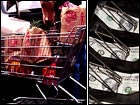|
U.S. retail sales dip
|
 |
February 13, 2002: 9:26 a.m. ET
But excluding autos, January retail activity much stronger than expected.
|
NEW YORK (CNN/Money) - U.S. retail sales fell slightly in January, the government said Wednesday, but excluding volatile auto sales activity, sales were stronger than expected as consumer spending, which fuels two-thirds of the world's largest economy, held steady.
Sales fell 0.2 percent in January, the Commerce Department said, after rising a revised 0.2 percent in December. Economists surveyed by Briefing.com expected sales to drop 0.2 percent.
Excluding volatile sales of automobiles and car parts, sales rose 1.2 percent after rising a revised 0.7 percent in December. Economists surveyed by Briefing.com expected sales excluding autos to rise 0.3 percent.
"Consumers, who have kept the economy from drowning during this recession, continued to spend, albeit cautiously, in January and may be leading the way to recovery," Oscar Gonzalez, economist at John Hancock Financial Services, said.
U.S. stock prices rose in early trading while Treasury bond prices fell.
To keep consumers spending despite a recession that some economists think began in March 2001 and an unemployment rate that has crept toward 6 percent, the Federal Reserve cut its target for short-term interest rates 11 times in 2001.
But it ended its rate-cutting campaign at its first meeting of 2002, based on signs of stabilization in manufacturing, consumer sentiment and other areas.
Automakers helped boost consumer spending at the end of 2001 by offering aggressive incentives such as zero-percent financing, and other retailers followed suit. Many economists worried that such aggressive offers had "stolen" sales from 2002.
Certainly, auto sales fell once those incentives were withdrawn, dropping 4.3 percent in January and 1.1 percent in December, but other sales held steady throughout the fourth quarter, helping boost U.S. gross domestic product (GDP) into positive territory.
In fact, December's sales data were revised sharply upward. In its preliminary report, the government thought sales including autos fell 0.1 percent and also fell 0.1 percent excluding autos.
Click here for CNN/Money's economic calendar
Helping fuel January's big gains was a 5.1-percent jump in sales at gasoline stations, attributable in large part to rising prices. But gas station sales were due for a rebound after falling 16.1 percent in 2001.
Other areas with significant gains in January were building materials, up 2.9 percent, health and personal care stores, up 2.3 percent, and clothing stores, up 2.5 percent.
"People have plenty of cash - and the inclination to spend it," said Ian Shepherdson, chief U.S. economist at High Frequency Economics Ltd.
Other economists disagree, pointing to a high level of household debt that they think must be reduced before consumers will feel comfortable increasing their spending significantly.
"It was not a surge in personal income that gave rise to the consumption boost in the fourth quarter," Economic Policy Institute economist Christian Weller said in a recent research note. "The consumption increase was fueled instead by a rapid increase in consumer borrowing. Consumers are slowly reaching the limit of their ability to shop."
As a result, some economists think the recovery from the latest recession could be sluggish, particularly if businesses - which started the recession in the first place - are slow to increase their spending again.
Consumer spending makes up two-thirds of U.S. GDP, the broadest measure of economic strength. GDP was slightly positive in the fourth quarter of 2001 after shrinking in the third quarter, meaning a technical recession - two straight quarters of shrinking GDP - may have been avoided.
Still, the GDP figure will be revised many times, and economists at the National Bureau of Economic Research, who define recessions differently, said a recession began last March and recently they said they don't have enough data to declare the recession over. 
|
|
|
|
|
|

|

